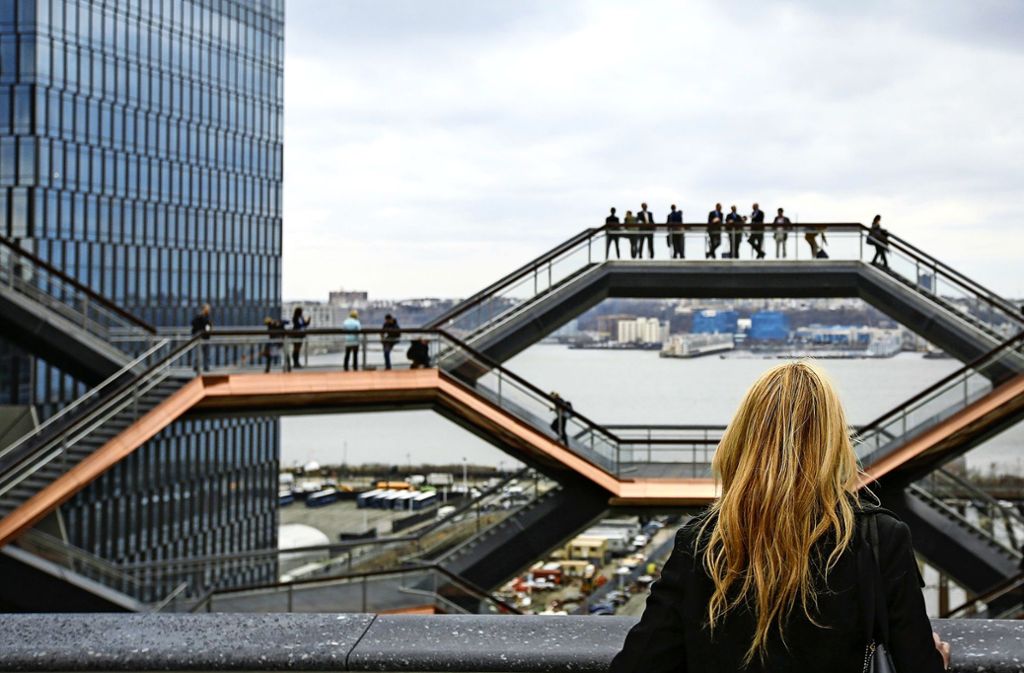The eye-catcher of the district is “The Vessel”: a steel sculpture made up of 154 nested stairs. Foto: Getty Images
Bigger than World Trade and Rockefeller Center: Hudson Yards are the most ambitious urban development project New York has ever seen
–
Of
March 18, 2019 – 11:18 am
— –
New York City – Manhattan has another attraction. Hudson Yards has given the real estate industry, which has never lost a marketable name, christened the new city district. The five central towers, the plans of which all come from the offices of star architects, soar into the sky with HD sharpness. A new glow and sparkle makes the old New York that sinks behind it look shabby and old.
The Hudson Yards is the most ambitious urban development project New York has ever seen. Real estate developer Steve Ross has invested 25 billion dollars in his vision of a golden city within the city. When it is finally completed in the next two years, the complex will house sixteen skyscrapers, which will contain 560,000 square meters of office space, 5,000 luxury apartments and a shopping area of 70,000 square meters. Neither the new World Trade Center Campus nor the historic Rockefeller Center can even come close in terms of scope and ambition.
The main attraction will probably be the viewing platform “The Edge”. The whole thing is garnished by an avant-garde art and performance space, called “The Shed”, which is preparing to overtake the MoMa and Lincoln Center as the center of the city’s cultural life. And in the middle of the campus is a walk-in art structure called “The Vessel”, which the creator Thomas Heatherwick likes to call the “Eiffel Tower of New York”.
The district was planned on the drawing board regardless of the context
But despite the undisguised megalomania of the project, the new district has grown almost unnoticed in recent years. You vaguely knew that something was going on on the west side. But even from Tenth Avenue, which you only visit when you drive through or work due to the lack of retail and restaurants, there was hardly anything to be heard or seen except for a site fence.
The Hudson Yards is pinned to the edge of Manhattan like a forgotten addition. Unlike the World Trade Center or the Rockefeller Center at the time, the problem of integrating the quarter into the urban fabric never arose during the planning. On the contrary, the attraction of the project, which was built over the rails of the subway depot, was that you could plan completely from the drawing board regardless of the context.
The result is a self-sufficient “gated community”, a cordoned-off area for the super-rich, in which they can sleep, work, shop, eat and go to the theater without exposing themselves to the chaos and dirt of the city. Everything about Hudson Yards is top notch – the restaurants with star chefs, the luxury boutiques, the cultural offerings. “We want residents to feel like they’re getting the best of everything,” writes Justin Davidson, New York Magazine’s critic. “You live in the best building in the best area in the greatest city in the world.”
A matter close to the heart of ex-Mayor Bloomberg
For New York, the Hudson Yards is a dramatic paradigm shift. The mega-block clears out the chaotic city, in which the building density for more than a century has created that much-cited “culture of density”, which ensures that beguiling anarchy and plurality that was once considered the essence of the city. They are replaced by orderly, hotel-like sterility, isolated from the life of the metropolis. Jeremiah Moss, author of the book “Vanishing New York”, a complaint about the lost soul of New York, calls the Yards an “anti-city” or a “plutocratic cloud”.
But the development is no coincidence. It follows the vision of Mayor Michael Bloomberg, who never made a secret of wanting to transform the city into a “luxury product”. In his 12 years in office, Bloomberg changed the usage regulations for 40 percent of the city’s area and thus gave private developers the key to New York.
The Hudson Yards were a matter close to the heart of Bloomberg from the start. The last fallow land in Manhattan above the tracks of the subway depot has always been a nuisance to the entrepreneur. In 2001, shortly after taking office, he used the city’s Olympic bid to rededicate the area.
The application did not work, but the starting shot for the development of the corner of Manhattan, which was not profitable, had been given. And in Steve Ross, Bloomberg found a partner who not only had the deep pockets for such a mega project, but also shared Bloomberg’s vision of a tidy, aseptic Manhattan for the wealthy.
Now that Bloomberg has been out of office for five years, New York is wondering if the Hudson Yards is a holdover from its long-drawn-out era or if the city’s hypergentrification never stopped. The continuation of Bloomberg’s planning policy through his successor Bill DeBlasio – the man who actually claimed to campaign for greater social justice – unfortunately gives rise to little hope. DeBlasio in Queens has just released an area seven times the size of Hudson Yards for development.
Justin Davidson finds solace in the fact that the Hudson Yards are so severely separated from the rest of the city. “Perhaps,” he commented, “the area hovers over the city like a spaceship that does not want to land, while the old, chaotic, dirty and noisy life of New York continues as ever below it.”
– .


![[국제]FDA Director “There was no external pressure for urgent vaccine approval…it met strict standards” [국제]FDA Director “There was no external pressure for urgent vaccine approval…it met strict standards”](https://image.ytn.co.kr/general/jpg/2020/1213/202012130138102844_t.jpg)